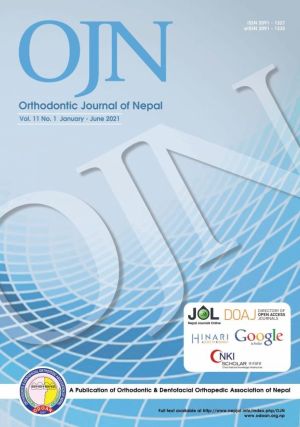Growth Pattern in Skeletal Class I Malocclusion: A Cephalometric Study
DOI:
https://doi.org/10.3126/ojn.v11i1.39088Keywords:
Hypodivergent, Hyperdivergent, Jarabak's Ratio, Growth pattern, sagittal relationshipAbstract
Introduction: Great emphasis has been given to the evaluation of sagittal apical base relationship in orthodontic diagnosis and treatment planning. The prediction of magnitude and direction of facial growth based on sagittal relationship will help in orthodontic treatment with growth modification. The objective of the study is to assess the growth pattern in skeletal Class I malocclusion.
Materials and Method: 104 subjects (52 male and 52 female) with the age between 18-30 years with Class I skeletal relation was selected from lateral cephalograms of patients visiting the Department of Orthodontics, Kantipur Dental College. The ANB angle was measured to assess the sagittal jaw relationship and the Jarabak’s ratio to access the growth pattern. Descriptive statistics were calculated for each parameter. Pearson’s test was done to evaluate the correlation between the parameters. Independent t-test was done to compare Anterior Facial height (AFH), Posterior Facial Height (PFH) and Jarabak’s ratio between male and female subjects.
Result: Among the total subjects with skeletal Class I malocclusion; hyperdivergent growth pattern was least (10.57%), followed by normodivergent (18.26%) and hypodivergent growth pattern (71.15%). Mean Jarabak’s ratio for hyperdivergent, normodivergent and hypodivergent growth pattern were 58.65±1.94, 63.98±0.85 and 69.98±4.13 respectively. Very strong correlation was found between AFH and PFH in hyperdivergent (r = 0.821) and normodivergent group (r =0.978). Strong correlation was found in hypodivergent group between AFH and PFH (r =0.743). Also, strong correlation was found in hypodivergent group between PFH and Jarabak’s ratio (r =0.643).
Conclusion: Hypodivergent growth pattern was the dominant growth pattern in skeletal Class I malocclusion. PFH influenced the determination of Jarabak’s ratio more than the AFH in hypodivergent growth pattern. Hypodivergent growth pattern is correlated with large SNB angle.
Downloads
Downloads
Published
How to Cite
Issue
Section
License
Copyright (c) 2021 Orthodontic & Dentofacial Orthopedic Association of Nepal

This work is licensed under a Creative Commons Attribution 4.0 International License.
Copyright © held by Orthodontic & Dentofacial Orthopedic Association of Nepal
- Copyright on any research article is transferred in full to the Orthodontic & Dentofacial Orthopedic Association of Nepal upon publication in the journal. The copyright transfer includes the right to reproduce and distribute the article in any form of reproduction (printing, electronic media or any other form).
- Articles in the Orthodontic Journal of Nepal are Open Access articles published under the Creative Commons CC BY License (https://creativecommons.org/licenses/by/4.0/)
- This license permits use, distribution and reproduction in any medium, provided the original work is properly cited.




